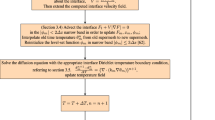Abstract
This study focusses on the growth of small precipitates within a matrix phase (see also den Ouden et al., Comput Mater Sci 50:2397–2410, 2011). The growth of a precipitate is assumed to be affected by the concentration gradients of a single chemical element within the matrix phase at the precipitate/matrix boundary and by an interface reaction, resulting into a mixed-mode formulation of the boundary condition on the precipitate/matrix interface. Within the matrix phase we assume that the standard diffusion equation applies to the concentration of the considered chemical element. The formulated Stefan problem is solved using a level-set method (J Comput Phys 79:12–49, 1988) by introducing a time-dependent signed-distance function for which the zero level-set describes the precipitate/matrix interface. All appearing hyperbolic partial differential equations are discretised by the use of Streamline-Upwind Petrov–Galerkin finite-element techniques (Comput Vis Sci 3:93–101, 2000). All level-set related equations are solved on a background mesh, which is enriched with interface nodes located on the zero-level of the signed-distance function. The diffusion equation is solved in the diffusive phase. Simulations with the implemented methods for the growth of various precipitate shapes show that the methods employed in this study correctly capture the evolution of the precipitate/matrix interface including topological changes. At the final stage of growth/dissolution physical equilibrium is attained. We also observe that our solutions show mass conservation as the time-step and element-size tend to zero.





Similar content being viewed by others
Explore related subjects
Discover the latest articles, news and stories from top researchers in related subjects.Notes
The \(\pm \) symbol represents the fact that the points in the set \(\mathcal{X }^{\pm }\) come from an edge over which \(\mathbf{\phi }(t^{n})\) changes sign.
References
Andersson JO, Helander T, Höglund L, Shi P, Sundman B (2002) Thermo-Calc and DICTRA, computational tools for materials science. Calphad 26:273–312
Chen S, Merriman B, Osher S, Smereka P (1997) A simple level set method for solving Stefan problems. J Comput Phys 135:8–29
Courant R, Friedrichs K, Lewy H (1928) Über die partiellen Differenzengleichungen der mathematischen Physik. Math Ann 100:32–74
Crank J (1984) Free and moving boundary problems. Clarendon Press, Oxford
Deschamps A, Brechet Y (1999) Influence of predeformation and ageing of an Al–Zn–Mg Alloy—II. Modeling of precipitation kinetics and yield stress. Acta Mater 47:293–305
Hu S, Henager CH Jr (2009) Phase-field simulations of Te-precipitate morphology and evolution kinetics in Te-rich CdTe crystals. J Crystal Growth 311:3184–3194
Javierre E, Vuik C, Vermolen FJ, Segal A (2007) A level set method for three dimensional vector Stefan problems: dissolution of stoichiometric particles in multi-component alloys. J Comput Phys 224:222–240
Kampmann R, Wagner R (1991) Materials science and technology—a comprehensive treatment, vol 5. VCH, Weinheim
Mullins WW, Sekerka RF (1963) Morphological stability of a particle growing by diffusion or heat flow. J Appl Phys 34:323–329
Osher SJ, Sethian JA (1988) Fronts propagating with curvature-dependent speed: algorithms based on Hamilton–Jacobi formulations. J Comput Phys 79:12–49
Osher SJ, Fedkiw RP (2002) Level set methods and dynamic implicit surfaces, 1st edn. Springer, The Netherlands
den Ouden D, Vermolen FJ, Zhao L, Vuik C, Sietsma J (2011) Modelling of precipitate nucleation and growth in binary alloys under elastic deformation: an application to a Cu-0.95%Co alloy. Comput Mater Sci 50:2397–2410
Perez M (2005) Gibbs–Thomson effects in phase transformations. Scr Mater 52:709–712
Porter DA, Easterling KE (1992) Phase transformations in metals and alloys, 2nd edn. Chapmann and Hall, London
Robson JD (2004) Modelling the evolution of precipitate size distribution during nucleation, growth and coarsening. Mater Sci Technol 20:441–448
Segal A, Vuik C, Vermolen FJ (1998) A conserving discretization for the free boundary in a two-dimensional Stefan problem. J Comput Phys 141:1–21
Segal A (2009) Sepran introduction. Ingenieursbureau SEPRA. Den Haag, The Netherlands
Sethian JA (1999) Fast marching methods. SIAM Rev 41:199–235
Soisson F, Barbu A, Martin G (1996) Monte Carlo simulation of copper precipitation in dilute iron–copper alloys during thermal ageing and under electron radiation. Acta Mater 44:3789–3800
Sussman M, Smereka P, Osher SJ (1994) A level set approach for computing solutions to incompressible two-phase flow. J Comput Phys 114:146–159
Tornberg AK, Engquist B (2000) A finite element based level-set method for multiphase flow applications. Comput Vis Sci 3:93–101
Vermolen FJ (2007) On similarity solutions and interface reactions for a vector-valued Stefan problem. Nonlinear Anal Model Control 12:269–288
Vermolen FJ, Javierre E, Vuik C, Zhao L, van der Zwaag S (2007) A three-dimensional model for precipitate dissolution in binary alloys. Comput Mater Sci 39:767–774
Zener C (1949) Theory of growth of spherical precipitates from solid solution. J Appl Phys 20:950–953
Acknowledgments
This research was carried out under the project number M41.5.09341 in the framework of the Research Program of the Materials innovation institute M2i (http://www.m2i.nl).
Author information
Authors and Affiliations
Corresponding author
Additional information
In memory of our late colleague Jeroen Colijn.
Rights and permissions
About this article
Cite this article
den Ouden, D., Segal, A., Vermolen, F.J. et al. Application of the level-set method to a mixed-mode driven Stefan problem in 2\(D\) and 3\(D\) . Computing 95 (Suppl 1), 553–572 (2013). https://doi.org/10.1007/s00607-012-0247-3
Received:
Accepted:
Published:
Issue Date:
DOI: https://doi.org/10.1007/s00607-012-0247-3




